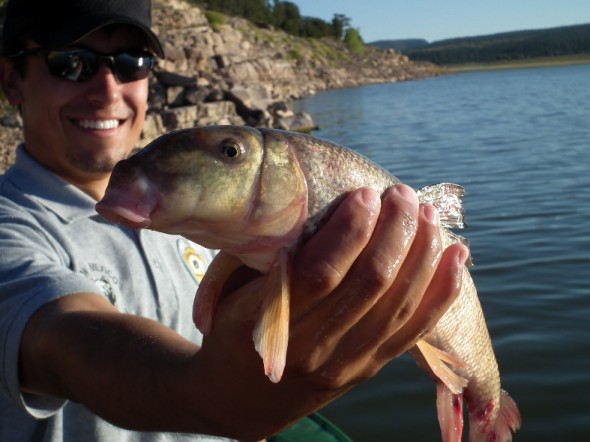
New Mexico Department of Game and Fish (NMDGF) Conservation Officer, Travis Nygren, shows off one of the giant tiger muskies found at Bluewater Lake in western New Mexico.
The Tiger muskie fishing at Bluewater Lake is so good these days its drawing anglers from across the state looking to land a trophy sized fish and maybe even break the state record.
“It’s crazy out here,” says Rodney Busch, 28, of Bluewater Village who frequently fishes the lake near his home. “There’s people coming from all over, even out of state, just to catch them.”
The state record has changed hands four times in just over a year and is currently held by Marcos Mata of Albuquerque after he snared a monstrous 50.5-inch, 38-pound, 2-ounce muskie at Bluewater Lake in July using a two-inch, silver, artificial minnow.
Prior to Mata’s catch the record was held by a guy from Edgewood who had taken it from a Truth or Consequences fisherman who had snagged it from an Albuquerque angler, according to state Department of Game and Fish records.
All took their record catch from Bluewater Lake in western New Mexico.
The International Game Fish Association’s North American record is for a 51-pound, 3-ounce tiger muskie caught at Lac Vieux-Desert, Mich. caught in 1919.
At the rate record catches are being recorded at Bluewater Lake someone could possibly take the national record too.
Tiger Muskie records are measured by weight not length.
Tiger muskies were planted in Bluewater and Quemado lakes back in 2003 by the state Department of Game and Fish (NMDGF) to get handle on a population explosion of unwanted white sucker and gold fish.
These undesirable “trash” fish compete for limited resources with “sport” fish such as trout and in both lakes they had grown out of control.

NMDGF Conservation Officer, Travis Nygren, holds up one of the many white sucker fish found in Bluewater lake that has prompted fishery managers to stock predatory tiger muskies in an effort to control their numbers.
Tiger muskies which are a sterile hybrid cross between a muskie and a pike can be raised in hatcheries and then stocked in lakes for use in controlling undesirable fish populations.
Tiger muskies are long, sleek predators armed with vicious teeth that tend to grow fast and big. They’ve been stocked in both lakes every other year since 2003, according to NMDGF coldwater fisheries biologist, Richard Hansen.
The tiger muskies have done such a good job in reducing the undesirable fish populations at both lakes that anglers can now catch and keep a single trophy tiger muskie over 40-inches long from either lake.
And now anglers who once sought trout at these two lakes are learning to fish for these monsters until the trout come back.
During a recent September survey of Bluewater Lake by Hansen he found the tiger muskie population to be thriving but white sucker and goldfish still present.

Richard Hansen, NMDGF Coldwater Fisheries Biologist, shows off one of the younger tiger muskies caught at Bluewater Lake during a recent population survey.
The biggest Tiger muskie netted during the survey was a 26-pounder measuring about 43-inches long and many more tiger muskies in the 20 and 30-inch range were also found.
Hansen said that not enough trout were located during the survey to make a determination about their status.
He noted that perhaps due to drought related low water levels and higher water temperatures that perhaps they were hiding out in the deeper water.
The NMDGF crew spent much of its time working just offshore in shallower water using gill nets and electro-shocking equipment.
But a similar survey this spring revealed a good sampling of trout, Hansen said and he will continue to evaluate the situation to determine how to proceed with any future trout stocking plans.
Hansen noted that trout appear to be coexisting well with tiger muskies in Quemado Lake and that methods used there to maintain the stocked trout population might work at Bluewater too. (See related article “Trophy Tiger Muskies in Quemado, Bluewater Lakes make for Amazing Angling” to learn more about trout and tiger muskie fishing at Quemado Lake. )
In the meantime the lake continues to draw anglers from all over for a chance to catch one of the prehistoric looking fish.

People aren’t the only ones fishing at Bluewater Lake as evidenced by the Osprey waiting in a tree on the shoreline for a chance to catch a meal.
Anglers wishing to fish for tiger muskies should be aware of some special equipment needed to do so successfully, according to Matt Pelletier, president of the 65-member New Mexico Muskies Inc., a local chapter of the national organization formed in 2008.
Anglers will need at least a seven foot long, heavyweight rod capable of handling at least a 20-weight line and a one-ounce lure with an open face spinning or bait casting reel.
Wire leaders are recommended and typical lures would include jerk baits that resemble goldfish, suckers and trout, Pelletier says.
Anglers should be equipped with a pair of long, needle nose pliers for dislodging hooks. They should also take along a pair of heavy nippers for cutting hooks off if needed and a pair of jaw spreaders to open the fish’s mouth and get at any embedded hooks.
Anglers should have a very large net or preferably, a sling net, in which the fish can be cradled in the water which is necessary for handling the fish properly without harming it or the angler.
“We practice and preach catch and release to conserve the resource,” Pelletier says.

Frequent Bluewater Lake angler, Rodney Busch, says a simple white diving lure like this beat up bomber has worked well for him at attracting strikes from tiger muskies.
Those fishing for tiger muskies need to practice patience and persistence as the fish feed on a limited schedule and anglers need to have their lures in the water when they’re ready to feed, Pelletier says.
Tiger muskies have a slow metabolism and after a good sized meal may not eat again for some time which accounts for their sporadic feeding behavior, he says.
The key to attracting a strike from a tiger muskie is to capitalize on its opportunistic, predatory instinct with jerks and motion of the lure that imitate a wounded or struggling prey, Pelletier said.
For more information about fishing for tiger muskies check out the club’s website at http://www.newmexicomuskiesinc.org.
For anglers looking to make the record book check out NMDGF’s website at www.wildlife.state.nm.us for rules, regulations and record applications.

On the way out to Bluewater Lake in west central New Mexico take time to check out the many attractions to be found along old Route 66 such as the many classic cars available at Oscars Auto Sales near Grants.
If You Go: Take I-25 south to I-40 and then head west to just past Grants. Take NM 412 at the Prewitt exit and follow to the lake.


